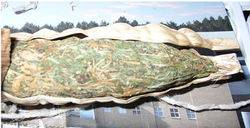Since I've never tried a real malawi cob and since I have a bit of malawi I want to play with. I'd like some help with doing some traditional curing techniques. Does afropips or anyone have any advice for making malawi cobs or zomba black cobs? Specifically how dry or cured should the herb be before wrapping it? How dry should the corn husk be and how tightly should it be wrapped? What kind of soil should I bury it in and how deep? We get freezing weather here in the winter but the soil rarely freezes past an inch or two. Any details are greatly appreciated.
Last edited:





